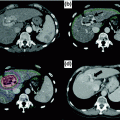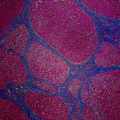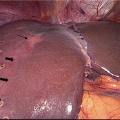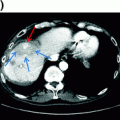Author; year
Design
Pts with liver metastases
Frx × dose
m-FU mts
Local control 2-years (%)
Survival 1-, 2-years (%)
Severe morbidity
Schefter 2005 [19]
Phase I
18
3 × 12–20 Gy
NR
NR
NR
None
Katz 2007 [20]
Retrospect
69
5 × 10 Gy
14.5
57
68, 24
None
McCammon 2009 [21]
Retrospect
81/141a
3 × 12 Gy
3 × 16 Gy
3 × 20 Gy
8.2
89
59
8
NR
8 grade ≥3: pneumonitis, dermatitis, soft-tissue inflammation/fibrosis, vertebral fracture
Rusthoven 2009 [23]
Phase I/II
47
3 × 12–20 Gy
16
92
77, 30
1 grade 3: soft-tissue necrosis
Lee 2009 [24]
Phase I
68
6 × 4.6–10 Gy
11
71 (1-yr)
79, 41 (3 yr)
7 grade ≥3: thrombocytesb, hepaticb, gastritis, lethargy, nausea
Goodman 2010 [26]
Phase I
19
1 × 18–30 Gy
17
75
62, 49
2 grade ≥3: duodenal ulceration, bowel obstruction
Rule 2010 [25]
Phase I
27
3 × 10 Gy
5 × 10 Gy
5 × 12 Gy
20
56
89
100
90, 50
78, 67
75, 56
1 grade 3: hepaticb
Van der Pool 2010 [22]
Retrospect
20
3 × 10–12.5 Gy
26
74
100, 74
3 grade 3: hepaticb and lethargy
Chang 2011 [27]
Retrospect
65
2–3 × 20 Gy
55
38 (2–yr)
77, 45
Acute: 2 grade 3 hepaticb
Late: 4 grade 3 hepatica and gastritis
Comito 2014 [28]
Phase II
42
4 × 12 Gy –3 × 25 Gy
24
80
80, 65
None
De Vin 2014 [29]
Retrospect
77/309a
10 × 4–5 Gy
12
33
32 (3-yr)
NR
Fode 2015 [6]
Retrospect
225/321a
3 × 15–22.5
29
LR: 13
80, 58
Acute: 11 grade ≥3: hepaticb, nausea pain, gastritis, skin, deterioration of performance status
Late: 3 grade ≥3: gastritis and skin
Scorsetti 2015 [30]
Phase II
42
3 × 25 Gy
24
91
81, 65
No grade ≥3
Meyer 2016 [31]
Phase I
14
1 × 35–40 Gy
30
100
85, 78
No grade ≥3
A number of studies have reported a dose-response effect with higher local control probability with the use of high biological equivalent doses [6, 21, 27, 28]. In a pooled analysis from three North-American centers, the actuarial local control rates were 86 and 42% at 1-year with doses of above and below BED10Gy of 75 Gy, respectively [27]. In the study from Denmark, the overall 2 years local recurrence rate was 13% and the rate was considerably reduced with BED10Gy over 100 Gy (hazard ratio 0.34) [6].
It has been claimed that liver metastases may be radio-resistant compared to metastases at other sites. The control rate of metastases is often lower in liver compared to lung, but it is unclear whether this relates to differences in radiosensitivity or to differences in radiation techniques. Lower control rates for CRC metastases were found is some studies [27, 32], but not in others [6, 21]. In the Danish study, the local relapse probability for metastases was higher in the liver compared to other sites, possibly explained by differences in radiosensitivity or by poorer imaging for target contouring of metastases to the liver compared to other sites [6].
Currently, there is no randomized phase III data to support the efficacy of SBRT for liver metastases, although a British randomized phase III trial (CORE) is expected to start recruiting patents with breast cancer oligometastases to conventional (systemic) therapy versus the same therapy plus SBRT for the detectable metastases (NCT02759783). The survival of patients in nonrandomized SBRT-studies depends in part on how well they are selected. However, studies of large cohorts of patients with metastatic cancer treated with SBRT have reported favorable survival rates even in negatively selected patients who were not eligible for surgery or radiofrequency ablation (Table 18.1).
Milano et al. found that patients with metastatic breast cancer to the liver and other sites of the body had a favorable survival compared to patients with metastatic cancer of other origin [33]. Fode et al. found a median overall survival of 6.1 year for breast cancer patients [6]. Due to the low number of patients, the survival of breast cancer patients in the Fode study was not statistically different from other patients’ survival. Katz et al. did not find the histological type influenced survival of the patients [20]. It seems obvious that some cancer types have a more indolent and less aggressive clinical appearance and for some cancer types there are several lines of systemic antineoplastic therapies that may affect the survival. Lack of differences in survival between tumor types may be a result of the patient selection.
Because of the limited knowledge on prognostic factors related to SBRT of patients with liver metastases, there is no consensus on the criteria to select patients. There is therefore considerable heterogeneity in patient and cancer characteristics among the published studies. Only few studies have patients numbers that are sufficient for assessment of prognostic factors. Cumulative GTV smaller than 3 cm was related to long overall survival in a study of patients with lung and liver metastases [28]. A large retrospective cohort study of patients primarily with liver metastases, but also some with lung and other metastatic sites, found that WHO performance status 0–1, solitary metastasis, size of largest metastasis under 3 cm, metachronous metastasis and pre-SBRT chemotherapy were related to favorable survival in a multivariate analysis [6].
SBRT of liver tumors is generally tolerated well. However, the esophagus, the stomach, the duodenum, and the large bowel should be considered in the selection of patients and in the treatment planning process because of their limited tolerance to radiation and the risk of severe adverse effects when they are exposed to large radiation doses. The liver tolerates large doses to relatively large volumes as long as a sufficient volume of liver is spared. Gastritis, gastric- or intestinal ulceration, chronic skin reaction, rib fracture, and hepatic failure seldom occur as late effects after SBRT for liver metastases [6].
There is growing use of SBRT for treatment of liver metastases. The results of prospective phase I/II trials and retrospective cohort studies are encouraging, but we are still missing high level evidence to prove its efficacy.
18.6 Particle Therapy with Protons and Carbon Ions
Due to their physical properties, protons and heavier ions have considerable potential in radiation therapy for primary and secondary liver tumors. The sparing is most prominent in volumes of normal tissue receiving the low-to-intermediate radiation dose. Because of the relatively low radiation tolerance of the liver, liver cancer patients are obvious candidates for particle therapy, especially if issues related to interplay effects and immature image guidance can be managed. A treatment planning study compared intensity modulated proton therapy (IMPT) and photons based intensity modulated radiation therapy (IMRT) in stereotactic body radiation therapy (SBRT) for liver tumors [34]. The study used a dose escalation risk-adapted prescription policy where the highest possible tumor dose was applied, provided that dose volume constraints to organs at risk were met. In 10 patients tested, there was sparing of normal liver tissue with protons compared to photons. With the highest dose level, the median V15Gy was reduced by 32% with use of IMPT. Nine of 10 cases could be treated at the highest dose level using IMPT whereas only two cases met this constraint at the highest dose level and six at the lowest dose level with use of IMRT. Other treatment planning studies report similar positive findings [35].
There are a number of published studies on proton and carbon-ion therapy of hepatocellular carcinoma (see Chap. 14). The particle therapy experience in treatment of metastases is limited to few case-reports and it does not allow for conclusions on the efficacy in treatment of oligometastases. Fortunately, a dose escalation study giving 3 × 12–20 Gy by use of passive scattering protons is actively recruiting patients with liver metastases at Loma Linda University (NCT01697371).
18.7 Radioembolization
Radioembolization or selective internal radiation therapy (SIRT) involves intra-hepatic administration of microspheres containing Yttrium-90 (90Y). The primary aims of radioembolization are to delay cancer progression and to improve survival. Studies of radioembolization without systemic antineoplastic therapy showed response rates of 35–75% in patients with CRC liver metastases (Table 18.2). When combined with systemic chemotherapy, the overall response rates increased to 76–91% [36, 37]. Two small randomized trials compared the combination of radioembolization and chemotherapy to chemotherapy alone in patients with CRC liver metastases [38, 39]. They both found improved response rates and progression-free survival and one study found improved survival in the SIRT arm. The large SIRFLOX study randomized 530 patients with mCRC liver-predominant disease referred for first-line chemotherapy between FOLFOX (±bevacizumab) chemotherapy and SIRT versus FOLFOX alone [40]. In this well-powered study the two arms had similar progression-free survival, but SIRT considerably delayed the progression in the liver by almost 8 months. Results of a similar multicenter study, the randomized FOXFIRE study, are also awaited [41].
Table 18.2
Results from randomized and large cohort studies of radioembolization (SIRT) for liver metastases
Author; year | Design | Treatment | Primary cancer | Number | m-FU (mts.) | Response rate [CR+PR] (%) | Survival 1-, 2-years (%) | Severe morbidity |
|---|---|---|---|---|---|---|---|---|
Stubbs 2006 [36] | Cohort | SIRT | CRC | 100 | 11 | 75 | 48, 18 | 9 severe, 2 deaths |
Kennedy 2006 [37] | Multicenter cohort | SIRT | CRC | 208 | 13 | 35 | 45% at 1 year in responders | 11% grade > 3 1 death (pulm. embolus) |
Sharma 2007 [44] | Phase I | Chemo+SIRT | CRC | 20 | NR | 90 | NR | 5 grade > 3 |
Gray 2001 [38] | Randomized | HAC+SIRT HAC | CRC | 74 | 42 | 44 18 P = 0.03 | 72, 39 68, 29 NS | 23 grade > 3 23 grade > 3 |
van Hazel 2004 [39] | Randomized phase II | Chemo+SIRT Chemo | CRC | 21 | NR | 91 0 P < 0.001 | 70, 52 50, 10 P = 0.02 | 13 grade > 3 5 grade > 3 |
van Hazel 2016 [40] | Randomized phase III | Chemo+SIRT Chemo | CRC | 530 | NR | 76 68 NS | NR (delayed progression in liver) | 83% grade > 3 73% grade > 3 |
Rhee 2008 [42] | Multicenter cohort | SIRT
Stay updated, free articles. Join our Telegram channel
Full access? Get Clinical Tree
 Get Clinical Tree app for offline access
Get Clinical Tree app for offline access

|




